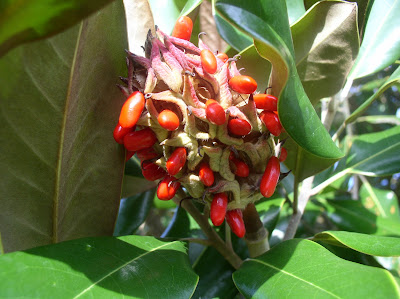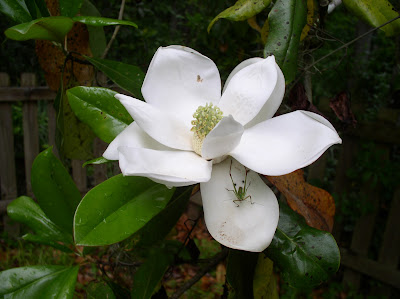Part VI. Southern Magnolia: Another Competitor
Florida’s lower Suwannee River and Cedar Keys region, including two outstanding National Wildlife Refuges, boasts more species of trees—as many as 130—than all but a few places in North America. Some of our trees are widely distributed in eastern North America, some are restricted to the southeastern coastal plain, and others reach their greatest prominence locally. A few years ago, our Friends of the Lower Suwannee and Cedar Keys National Wildlife Refuges organization designed a tee-shirt featuring six iconic species of trees occurring on the refuges. Our series of blog posts will begin by considering each of these six species. This, the final installment, focuses on southern magnolia.
Southern magnolia (Magnolia grandiflora) is an iconic southern species that, although nowhere dominant on the Lower Suwannee refuge, can be expected to increase in abundance as the vegetation of moist hammocks matures. These trees may share dominance with other species in older forested stands. In our area southern live oak (Quercus virginiana) is an expected co-dominant in such mature communities.
When grown in full sunlight as in ornamental plantings, southern magnolia trees acquire a pyramidal shape, but when grown in sites having a forest canopy, they are more columnar in shape. Bearing leaves on the lower branches is a sign of shade tolerance; shade intolerant species usually lack branches on the lower trunk because leaves on the upper branches shade them out. The large, flat leaves of magnolias are efficient at capturing sunlight. As in many broad-leaved evergreen trees the thick waxy coating of magnolia leaves presumably helps to prevent excessive moisture loss in the winter season, but it likely also restricts the transmission of sunlight to the chloroplasts and limits shade tolerance. When exposed to full sun, leaf undersurfaces have a reddish appearance caused by tiny hairs, and these also might be an adaptation to prevent water loss.
Like our other iconic species magnolias possess a blend of tolerances that allow them to persist in a variety of situations. Relatively fast growth and prolific seed production are other characteristics of southern magnolias that are more common in pioneers than in climax adapted species.
Southern magnolias generally occur on sites with moist soils, but they are intolerant of inundation and thus require good drainage. When found near riverbanks and seepage areas they are usually far up on the banks where drainage is good. They do have extensive root systems which convey some degree of drought tolerance. Adult trees have bark that is relatively resistant to fire, and their extensive roots promote regeneration by sprouting after adults are top killed by fires.
One other species of magnolia is found in the region. Sweetbay magnolias (Magnolia virginiana) are often smaller than southern magnolias and tend to occur in wetter areas, on the edges of ponds and ditches for example. The leaves are somewhat narrower and less glossy than those of southern magnolia, and they have a distinctive silvery hue on the undersides.
Southern magnolia is sometimes called “Bull Bay” and together with sweetbay it is one of five kinds of trees possibly occurring in the area that have the word “bay” in their common names. The two magnolias are clearly related as are two of the others, red bay (Persea borbonia) and swamp bay (P. palustris), although neither of the latter two is related to the magnolias. A fifth species, loblolly bay (Gordonia lasianthus), is not closely related to any of the others. All five, however, are evergreen and vaguely similar in appearance. Their common names seem to come not from their associations with specific habitats but from their resemblance to one another.
| . |
 |
Southern Magnolia Seeds.
The colorful seeds are attractive to birds and thus provide an effective
dispersal mechanism. |




No comments:
Post a Comment